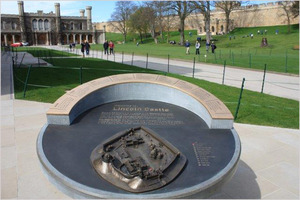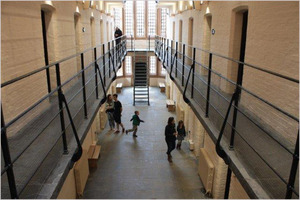 From the eastern ramparts of Lincoln Castle, England’s history is laid out around me in one eye-catching package. Inside the castle walls, green lawns surround a variety of intriguing buildings from the Georgians to the 21st century. And beyond the battlements, the three towers of Lincoln Cathedral dominate the landscape, a beacon for the pilots of Bomber Command returning to nearby airbases during World War II.
From the eastern ramparts of Lincoln Castle, England’s history is laid out around me in one eye-catching package. Inside the castle walls, green lawns surround a variety of intriguing buildings from the Georgians to the 21st century. And beyond the battlements, the three towers of Lincoln Cathedral dominate the landscape, a beacon for the pilots of Bomber Command returning to nearby airbases during World War II.
But arguably the most significant piece of history is hidden from view, one of just four surviving copies of the Magna Carta and generally agreed to be the best. Thanks to a £22 million pound project, Lincoln Castle Revealed, this precious document is now housed in a purpose-built Magna Carta vault below ground.
Fireproof, dimly lit and with temperature and humidity controls, this subterranean treasure house offers the ideal display conditions for the Great Charter of 1215, which is revered across the world. Much has already been written around the 800th anniversary of the signing by King John at Runnymede with many English towns involved in some way, but few can claim a closer association than Lincoln, and short films in the interpretation centre put the document in both its historical and global context.
 But the Magna Carta Vault is only part of the Lincoln Castle Revealed project which opened its doors to much acclaim at Easter. Particularly impressive is the new Medieval Wall Walk which runs for one-third of a mile round the entire circuit of the battlements. Undulating from one tower to another and badly crumbling in places, only small sections of the ramparts were previously accessible. Now they are not only complete, broad and safe, but partially accessible to wheelchairs and buggies, thanks to a new cylindrical lift. Most dramatic is the view from the east wall towards the Cathedral West Front.
But the Magna Carta Vault is only part of the Lincoln Castle Revealed project which opened its doors to much acclaim at Easter. Particularly impressive is the new Medieval Wall Walk which runs for one-third of a mile round the entire circuit of the battlements. Undulating from one tower to another and badly crumbling in places, only small sections of the ramparts were previously accessible. Now they are not only complete, broad and safe, but partially accessible to wheelchairs and buggies, thanks to a new cylindrical lift. Most dramatic is the view from the east wall towards the Cathedral West Front.
Disabled people and folk with wheels will also appreciate the elegantly integrated mix of steps and ramps that lead to the ticket office and visitor entrance at the front of the old Georgian debtors’ prison. This in turn leads into the Victorian prison where you can see the old cells and visit the chapel, one of only two in the world that show the harsh ‘separate system’. The other one, greatly restored, is in Tasmania!
 Prisoners were kept here in solitary conditions to reflect on their misdeeds and this even extended to church services when they were confined in tall boxes, able only to see the head of the priest standing on a high platform. The boxes, understandably, are not disabled friendly, but large parts of the Victorian prison are, although some areas have very narrow walkways and may not be suitable for wheelchairs.
Prisoners were kept here in solitary conditions to reflect on their misdeeds and this even extended to church services when they were confined in tall boxes, able only to see the head of the priest standing on a high platform. The boxes, understandably, are not disabled friendly, but large parts of the Victorian prison are, although some areas have very narrow walkways and may not be suitable for wheelchairs.
Lincoln Castle has always been about keeping people both in and out, and the new exhibitions echo the themes of justice, freedom and the rights of the common man. Today the Crown Court still operates from another Victorian building within the grounds. An adjacent new building, with environmentally-friendly grass roof, houses the Heritage Skills Centre, home to craftsmen working in stained glass, stone, plaster and a variety of other essential skills.
 I left Lincoln Castle Revealed convinced that this superb new tourist attraction will bring a new wave of visitors into a heritage town which is all too often overlooked by visitors. The cobbled streets of the historic centre are fringed with independent shops and cafes, and you can trace the history’s Roman heritage by following the Roman Trail linking sections of wall, gatehouse ruins and even an impressive gateway.
I left Lincoln Castle Revealed convinced that this superb new tourist attraction will bring a new wave of visitors into a heritage town which is all too often overlooked by visitors. The cobbled streets of the historic centre are fringed with independent shops and cafes, and you can trace the history’s Roman heritage by following the Roman Trail linking sections of wall, gatehouse ruins and even an impressive gateway.
Meanwhile the cathedral is an absolute must whether you wander at will, take a guided tour at ground level, or follow your leader up the tower to share the view with the resident falcons. If you like history, look for the tomb that contains the remains of Eleanor of Castille, wife of Edward I, identifiable by the Latin inscription around the rim. The Queen died nearby and her organs were buried in Lincoln before her body was carried to London, Eleanor Crosses being erected along the route (a fragment of one stands in the castle grounds). You’ll also find Kathrine Swynford here, third wife of John of Gaunt.
 I also liked finding an engineering exhibition in full swing in the nave, a reflection of one of the city’s specialisations, and a reminder of the days when cathedrals were as much meeting and market places as centres of worship. It’s certainly not every day you find an electric BMW parked beneath the angels!
I also liked finding an engineering exhibition in full swing in the nave, a reflection of one of the city’s specialisations, and a reminder of the days when cathedrals were as much meeting and market places as centres of worship. It’s certainly not every day you find an electric BMW parked beneath the angels!
Don’t miss the side chapels to the armed forces, the Airman’s Chapel in particular that recalls those brave young men of Bomber Command. A day following Lincolnshire’s Aviation Heritage Trail will take you out of the city to the historic airfield at East Kirkby, the Battle of Britain Memorial Flight centre at Coningsby, and to the Petwood Hotel at Woodhall Spa, home of the famous Dambusters. And new in Lincoln this summer will be the International Bomber Command Centre, a point for recognition, remembrance and reconciliation.
 Back in Lincoln, don’t miss the ruins of the Old Bishop’s Palace, maintained by English Heritage and containing Britain’s most northerly vineyard, a symbol of Lincoln’s town-twinning with Germany. We stayed over next door in The Old Palace, a charming, traditional hotel which is part of the Diocesan complex tucked into the hillside beneath the cathedral. The small dining room has lovely views over the garden to the rear which in turn offers a panoramic perspective on the back of the hotel and up to the cathedral towers.
Back in Lincoln, don’t miss the ruins of the Old Bishop’s Palace, maintained by English Heritage and containing Britain’s most northerly vineyard, a symbol of Lincoln’s town-twinning with Germany. We stayed over next door in The Old Palace, a charming, traditional hotel which is part of the Diocesan complex tucked into the hillside beneath the cathedral. The small dining room has lovely views over the garden to the rear which in turn offers a panoramic perspective on the back of the hotel and up to the cathedral towers.
 Our comfortable room was in the atmospheric Lodge annexe, a former ecclesiastical building with pointed windows and leaded lights. Crossing the garden at night you get the full impact of the illuminated cathedral and despite being in the heart of the city, we heard absolutely no noise.
Our comfortable room was in the atmospheric Lodge annexe, a former ecclesiastical building with pointed windows and leaded lights. Crossing the garden at night you get the full impact of the illuminated cathedral and despite being in the heart of the city, we heard absolutely no noise.
We left Lincoln thinking that this is a city which has been in tourism’s twilight zone for too long. Hopefully it will now get the attention it deserves. Town, castle and cathedral offer a varied programme of cultural and heritage events throughout the year, as well as showcasing the county’s enviable food heritage. Definitely one of my best UK discoveries for 2015!
For excellent hotel accommodation close to Lincoln, stay at Washingborough Hall Country House Hotel











